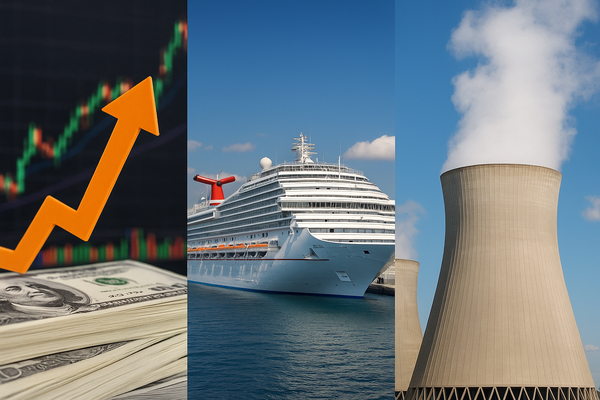
Headline data: Electronic Arts agreed to a $55.0 billion all-cash buyout that sent EA shares up 14.9% on the announcement; Carnival Corporation reported record third-quarter results with net income of $1.90 billion (adjusted net income $2.00 billion) on revenue of $8.153 billion; Oklo closed at an all-time high of $142.65 after a year-to-date rally of roughly 1,200% despite a recent >20% intraday dip on insider-trading headlines.
Event-driven premium: EA’s $55 billion proof that large buyouts still move markets
The largest theme this week is a deal-size signal: a $55.0 billion leveraged buyout for Electronic Arts that pushed EA shares higher by 14.9% on the day of the announcement. Market commentary points to a near-term arbitrage of roughly 4% available to holders “until closing” on the deal — that number aligns with published take-private spreads that often compress as regulators and shareholders sign off. The sheer headline valuation — $55.0 billion — forced immediate repricing in sector multiples and liquidity premiums, with trading volumes described as “higher than average” on deal news.
Why EA matters to traders and institutions: price discovery and financing bandwidth
For active traders the EA transaction provides two concrete items to watch: deal premium and implied financing cost. A $55.0 billion transaction typically implies several billion in debt financing; if debt markets reprice by 100 basis points it can change the equity return math materially. Institutions calibrating exposure should note the 14.9% one-day jump in EA and the cited “nearly 4%” carry to closing — both figures are actionable for portfolio rebalancing and relative-value desks calculating takeover arbitrage returns versus funding costs.
Cruise demand validates consumer discretionary upside: Carnival’s $2.0 billion adjusted quarter
Carnival’s quarter delivered measurable upside: revenue of $8.153 billion versus a consensus $8.101 billion, producing adjusted net income of $2.00 billion and adjusted diluted earnings of $1.43 per share versus analyst expectations near $1.32. Net income on a GAAP basis was $1.90 billion (or $1.33 per diluted share on one release). Those figures translate into a revenue increase from $7.90 billion a year ago to $8.153 billion this quarter — a sequential and year-over-year gain of approximately $253 million, or about 3.2%.
How traders should read Carnival’s print: booking momentum, margin expansion and volatility
Carnival also reported adjusted EBITDA of $3.0 billion and said booking trends outpaced capacity growth — management raised full-year views after the print. The market reaction was immediate: Carnival shares opened up c.5% premarket and printed higher intraday on the earnings beat. For allocators this implies two quantified levers to model: (1) incremental margin capture from a $3.0 billion adjusted EBITDA base, and (2) revenue upside sensitivity to booking growth that, in Carnival’s report, drove the $253 million revenue increase versus the prior year.
Speculation and fundamentals collide: Oklo’s construction milestone and 1,200% run
Oklo’s equity action is the classic speculative-on-fundamentals mix: the company announced groundbreaking at Idaho National Laboratory for its first commercial-scale Aurora powerhouse and disclosed plans for a nuclear fuel recycling facility in Tennessee, while equity flows reflected that operational cadence. The stock closed at $142.65 on Sept. 23 and is up roughly 1,200% year-over-year by one reported metric. Barclays initiated coverage with an Overweight and Oklo committed approximately $5.0 million to a transatlantic partner, underscoring institutional investor interest measured in single-digit millions on strategic bets.
Risk profile and price action: why Oklo requires tactical sizing
That 1,200% YTD number masks episodic risk: Oklo dipped more than 20% on a disclosure about insider trading before recovering, highlighting headline-driven gamma. For traders, the combination of a $142.65 trading print, Barclays’ Overweight initiation and a $5.0 million strategic contribution suggests a high-beta instrument where event windows (groundbreaking, permitting milestones, and coverage initiations) create intraday moves greater than 20% and sustained trends that can outpace typical sector volatilities.
Connecting the dots: what $55B buyout, a $2B cruise quarter and a 1,200% reactor rally tell us
Numerically, the week created three durable takeaways. First, the $55.0 billion EA buyout compressed takeover spreads and reallocated liquidity into large-cap event trades (EA +14.9% on announcement). Second, Carnival’s quarter — $8.153 billion in revenue and $2.00 billion adjusted net income — reaffirmed a consumer spending vector that can sustain cyclical plays and help justify higher travel discretionary multiples. Third, Oklo’s $142.65 close and 1,200% YTD gain show thematic allocation into clean baseload supply can produce outsized returns but with >20% headline-driven drawdown risk.
Actionable metrics for portfolios and trading desks
Practical steps with numbers: arbitrage desks should monitor EA’s announced spread (c.4% until closing) versus prevailing financing costs (watch bank-built debt margins); long/short funds can size Carnival exposure to capture a potential 3.2% revenue uplift year-over-year translated into a $3.0 billion adjusted EBITDA base; and momentum desks should cap position sizing in Oklo given reported intraday swings >20% while noting Barclays’ Overweight signaled institutional runway for further re-ratings. Each trade idea is explicit: measure carry (EA ~4%), earnings upside (Carnival +$253M revenue Y/Y, $1.43 adjusted EPS vs $1.32), and volatility (Oklo >20% dips, $142.65 close, 1,200% Y/Y).
Conclusion — calibrated exposure, event calendars and risk budgeting
Quantitatively, this week offered a $55.0 billion takeover, a $2.00 billion adjusted quarter and a $142.65 reactor-stock close that was up ~1,200% year-over-year. For institutional investors and active traders the imperative is clear: align position sizes to event probabilities (takeover approvals, earnings beats, permitting milestones) and use concrete metrics — % carry to close, dollar revenue beats, and observed intraday volatility — to govern exposure. Those three numbers — 14.9% (EA move), $2.00 billion (Carnival adjusted net income), and 1,200% (Oklo YTD advance) — are the inputs to short-term P&L scenarios and longer-term allocation decisions.












